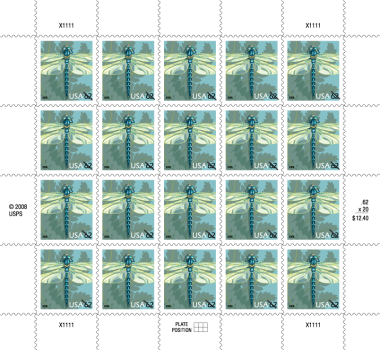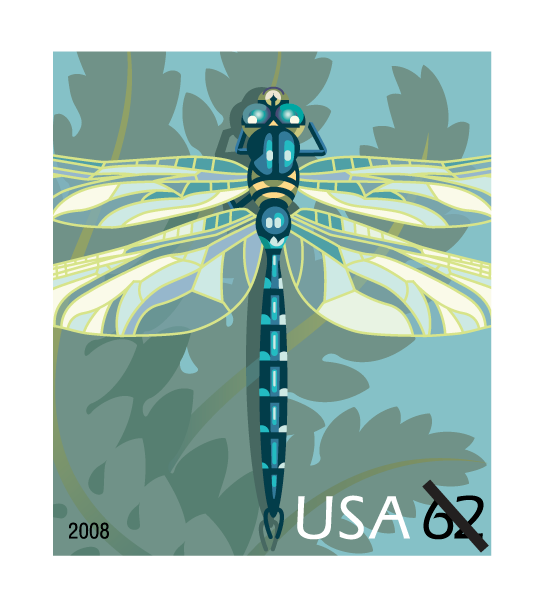
About This Stamp
This 2008 issuance features the dragonfly, one of the oldest insects in the world. Fossil records show that dragonfly species have existed for 300 million years, which places them well before dinosaurs and 150 million years before birds.
Members of the order Odonata are commonly called dragonflies, but the order includes damselflies as well. Though the two insects share many similarities, like long, slender bodies and four transparent wings with a maze of veins running through them, dragonflies are usually slightly larger than damselflies. Also, the hind wings of dragonflies have a broader base than the forewings, whereas the wings of damselflies are all similarly shaped and sized. Another way to tell them apart is to watch them at rest: Dragonflies keep their wings extended horizontally; most damselflies hold their wings vertically toward the rear.
Dragonflies are found in freshwater areas all over the world. The larvae are aquatic predators that go through several molting periods. They breathe through gills and thrive on small aquatic insects and tadpoles. Some species remain in larval form for just a few months, but others may do so for several years. Unlike butterflies and many other insects, dragonflies bypass the pupal stage and transform into full-grown adults, developing their color in a few days.
An adult dragonfly has a very flexible body and large compound eyes that make up most of the head. With a quick turn of its head, the insect can scan 360 degrees. Such amazing vision helps make dragonflies excellent hunters. The next meal could be almost any available insect, and this adaptability has probably helped dragonflies survive for as long as they have.
Stamp Art Director

Carl T. Herrman
As an art director for the U.S. Postal Service® for more than 15 years, Carl T. Herrman designed more than 50 stamps and guided more than 250 stamp projects, including Marilyn Monroe, James Dean, Humphrey Bogart, and Comic Strip Classics. He also served as art director for five of the Celebrate the Century stamp panes. He has won more than 260 awards for design and design management, including two gold medals from the Society of Illustrators.
Herrman’s career has included positions as Director of Creative Services and adjunct professor at the University of North Florida in Jacksonville, and Director of Marketing and Publications for the University of California at Irvine. He has provided consulting services for the Smithsonian Institution, the National Trust for Historic Preservation, and numerous academic institutions. Herrman lives in Carlsbad,California.
Stamp Artist

Nancy Stahl
A native of Long Island, New York, Nancy Stahl studied art at the University of Arizona, the Art Center College of Design in Los Angeles, and the School of Visual Arts in New York City. Her career can be split nearly equally between traditional media and digitally created art. Originally working in graphite, she experimented with a variety of media before making gouache paintings her signature style. She learned to work digitally starting in 1989 and abandoned her paints a few years later. Stahl’s clients have ranged from newspapers and magazines such as The New York Times, The Wall Street Journal, TIME magazine, and Der Spiegel to corporate identity, packaging and billboards for companies such as The Disney Family Museum, Sharffen Berger chocolates, and Stonyfield Farms. Her love of craft has allowed Stahl to accept assignments as varied as creating lace for the Metropolitan Museum of Art’s Costume Institute and knitting Christmas stamp designs in 2005 for the US Postal Service®. Her work is represented in The Illustrator in America, 1860-2000 by Walt Reed and Rolling Stone: The Illustrated Portraits edited by Fred Woodward. An instructor in the Independent Study Masters Degree program at Syracuse University, Stahl has also taught illustration at the School of Visual Arts and the Fashion Institute of Technology. In 2012, She was elected to the Society of Illustrators Hall of Fame. Stahl works from her studio in New York City where in her leisure time she pursues her hobby of computerized knitting.
She has designed more than 40 stamps for the U.S. Postal Service including the New York Public Library Lion (2000), three stamps for the Stars and Stripes issuance (2015), 19th Amendment: Women Vote (2020), and most recently Women's Rowing (2022). Stahl is especially well known for her highly stylized animal stamps, including Bighorn Sheep (2007); the Save Vanishing Species semipostal (2011, reissue 2014), featuring a portrait of an Amur tiger cub; Penguins (2015); Frogs (2019); and Save Manatees (2024).
